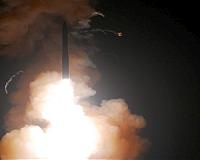| . |  |
. |
Melbourne (UPI) Dec 1, 2010 Australia has placed its acquisition of Joint Air-to-Surface Standoff Missiles on the "projects of concern" list because of procurement delays. Minister for Defense Stephen Smith and Minister for Defense Materiel Jason Clare said they are concerned that the procurement process -- Project AIR 5418 Phase 1 -- is running late. The Lockheed Martin cruise missile project for Australia, given the green light in 2004, is for deployment on F/A-18A/B aircraft. But in a speech to the Department of Defense Senior Leadership Group, Smith said there has been a breakdown in communication between the government and suppliers. "Government has not been kept properly and fully informed as to the progress with respect to this major project," Smith said. "It is essential for government to be appropriately informed about the delivery of complex and important capabilities so that appropriate steps can be taken to manage issues that emerge in relation to cost, capability or schedule." The projects of concern list was established in 2008 to focus the attention of defense officials, manufacturers and the supply chain on improving project development and supply when there appeared to be a problem such as scheduling, cost, capability delivery or project management. The addition of the JASSM brings the number of projects on the list since 2008 to 18. But five have been removed because of improvements to the processes, and one has been taken off the list because it was canceled, a government statement said. Other projects on the so-called name-and-shame list are Boeing's delayed Wedgetail Airborne Early Warning and Control aircraft and the Anti-Ship Missile Defense radar upgrades for ANZAC Class Frigates -- a joint project by CEA Technologies -- and the Anzac Ship Integrated Material Support Program Alliance comprising the DMO, Saab Technologies Australia and BAE Systems. Smith said the JASSM project will get "additional scrutiny and senior officer oversight in the lead up to the test firing and in the development of subsequent advice to government." The 14-foot long-range conventional missile is used by the U.S. Air Force and U.S. Navy to destroy high-value but well defended fixed or relocatable targets from ranges of more than 200 nautical miles. The 2,250-pound missile is a "fire-and-forget" weapon with guidance through inertial navigation with updating from a global positioning system. The single vertical tail AGM-158A JASSM is powered by a Teledyne CAE J402 turbojet. When mounted on a delivery aircraft, the wings are folded inwards to reduce size and they flip out upon launch. The next major stage in Australia's JASSM project is a live firing from an Australian F/A-18A/B Hornet aircraft in the United States by early 2011, the Ministry of Defense said. Earlier this month Lockheed Martin said the JASSM extended-range version flew two successful test flights at White Sands Missile Range, N.M. This boosted the program's success rate to 91 percent in 11 flights, a company statement said. The first JASSM-ER missile was released from an altitude of 13,000 feet and a speed of 0.72 Mach, while the second missile was released from 30,000 feet at 0.88 Mach. The live missiles, released from B-1B bombers, effectively navigated to and destroyed their intended targets. The missile also adjusted its cruising speed throughout the flight profile based on winds and other atmospheric data. "JASSM-ER delivered outstanding performance through developmental flight testing as evidenced by 10 of 11 successful flights," Alan Jackson, JASSM program director at Lockheed Martin Missiles and Fire Control, said.
Share This Article With Planet Earth
Related Links Learn about missile defense at SpaceWar.com All about missiles at SpaceWar.com
 NATO mulls missile cooperation with Russia
NATO mulls missile cooperation with RussiaMoscow (UPI) Nov 29, 2010 NATO leaders have snubbed suggestions by Russian President Dmitry Medvedev to unite his country's missile system with that of the Western alliance. Although Russian officials denied that Medvedev made a specific proposal, he moved to broach the issue of uniting a missile shield being built by the 28 NATO allies with Russia's own version during a closed-door meeting with NATO leaders in ... read more |
|
| The content herein, unless otherwise known to be public domain, are Copyright 1995-2010 - SpaceDaily. AFP and UPI Wire Stories are copyright Agence France-Presse and United Press International. ESA Portal Reports are copyright European Space Agency. All NASA sourced material is public domain. Additional copyrights may apply in whole or part to other bona fide parties. Advertising does not imply endorsement,agreement or approval of any opinions, statements or information provided by SpaceDaily on any Web page published or hosted by SpaceDaily. Privacy Statement |